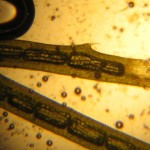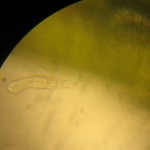
While not quite as dramatic as drilling through four kilometers of ice to find signs of live in an Antarctic lake that’s been isolated from the rest of the world for over 100,000 years, we observed filamentous algae blooming under the clear ice on the creek earlier this winter.

I collected some of the algae and put it into the fish tank; I was hoping I could use it when we looked at plant cells because aquatic plants tend to have larger cells that are easier to see under the microscope.
However, one of my students is keeping tadpoles (also from the creek) in the fish tank. She noticed that the tadpoles were hanging out on top of the algae, and the algae was disappearing. Well, at least we’d solved her problem about what to feed the tadpoles.

While the filamentous algae might not be as good as the Egeria densa for plant-cell microscopy, it does host quite a number of other microbes that are fascinating to look at.
Ecological Role of Algae
Based on these observations, ecologically the filamentous algae does not just provide habitat for protists and other microbes, it also appears to be a significant source of food for larger animals, like the tadpoles, and probably also the small fish that live in the creek.

Therefore, I’d hypothesize that in the winter, when the fish disappear, and most of animal life is quite subdued, the algae blooms because it’s not being grazed on nearly as much (see the picture above). When the weather warms, however, it’s the turn of the algae to repressed.
It would be interesting to have a student monitor the algae growth, and the fish/tadpole population, over the course of the school year to see if the relationship is more than just coincidence.
P.S. After our last snowfall, the melting snow has put a lot of water into the creek, and all the algae appears to have been washed away.